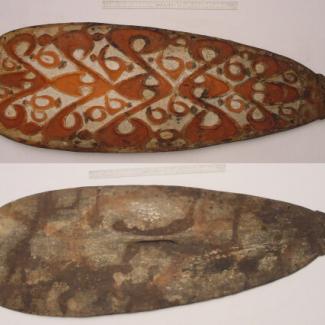This is a large wooden war shield carved by the Asmat people in Papua New Guinea in the second half of the twentieth century. It is composed of lightweight brown sago wood, which has been treated and painted with various pigments of red, white, and black. The base color for the surface is white, while accents and designs have been painted in red and black. The top of the piece is pointed, with an ornamental triangular cap. The bottom of the piece shows degradation of colors and wear from being planted into muddy soil during use. The surface features beautiful geometric shapes and patterns which denote ancestry figures and magic wards. The rear surface of the piece features remnants of red and white pigments around a small handle. The piece is a perfect example of the exquisite level of craftsmanship found in Asmat cultural art.
War in Asmat society was very common and ritualistic in nature. Hostile tribes would meet one another to perform headhunting raids and other forms of combat in order to resolve disputes and to balance spiritual scales disturbed by unnatural deaths in their communities. Warfare was a means of enacting vengeance for the deceased and as a means of appeasing angry ancestral spirits. Shields produced for war were highly important as both practical and ceremonial tools. In combat, they were used to protect the wielder and to frighten enemies. The designs carved on the surface represented the wielders’ ancestors and magic wards in ways that gave them protection and power. Ceremonial shields were produced for events such as building dedication ceremonies and funeral rites. Asmat wielders would thump the shields into the ground as part of these rituals, resulting in the degradation of paint layers on many shields in museum collections. Each shield was carved by its wielder, giving them an incredible personal significance. They are pieces intended to tell stories of their ancestors and to demonstrate their dedication to honoring ancestral spirits. The design and shape of shields vary widely by region, and no two are exactly the same.
Colors: Red, White, Black, Brown

